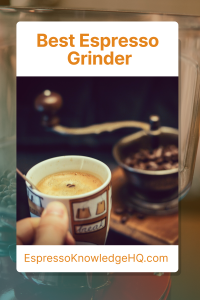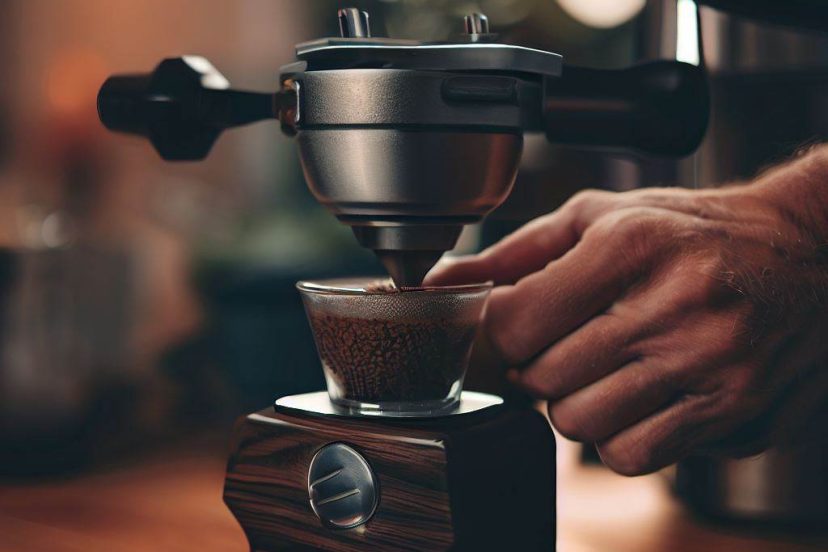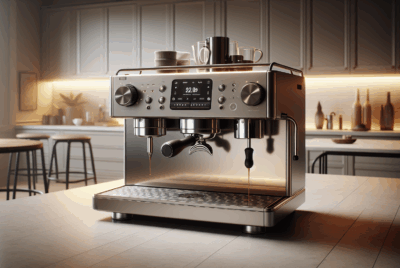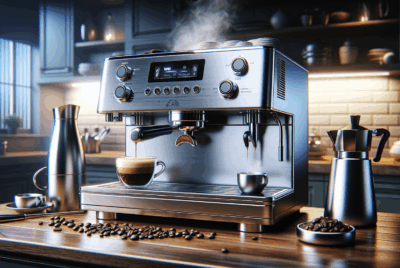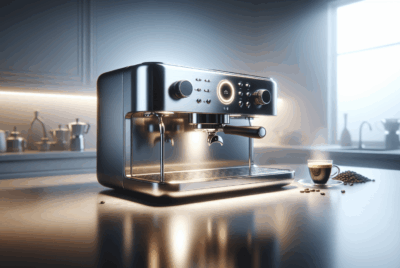Best Espresso Grinder: The Hunt Is On
As an Amazon Associate, I earn from qualifying purchases, at no additional cost to you. Disclaimer
Introduction
As a coffee enthusiast, I can’t stress enough how the perfect grind can dramatically transform your espresso experience. But with the market teeming with options, how do you find the best espresso grinder for you? Let’s dive in and unravel this together.
The Game-Changing Impact of a Quality Espresso Grinder
Now, you might be thinking: “Why do I need a top-notch espresso grinder?” After all, coffee is coffee, right? Wrong. Here’s where we unravel the profound effect a good espresso grinder can have on your brew.
Every espresso lover knows that the journey to a superb cup of coffee begins with the beans. But it’s not just about having high quality beans, it’s about how you handle them.
This is where the grinder becomes your best friend.
The Symphony of Flavors Unlocked by the Perfect Grind
Imagine this. You’ve just bought a fresh batch of your favorite gourmet beans. The aroma is intoxicating; your excitement is palpable. You can’t wait to brew your first cup. So, you reach for your trusty grinder and start the process. But the end result? A cup of joe that’s more ‘meh’ than ‘wow.’ So, what went wrong?
Here’s the deal. Your grinder is the gatekeeper to your coffee’s flavor. It’s the first step in releasing the magical symphony of flavors trapped inside each bean. If your grinder fails at this task, your brew will suffer, no matter how exotic or high-quality your beans are. This is why a good grinder is a non-negotiable for any serious espresso lover. It’s the secret weapon in your brewing arsenal that ensures a consistently delightful espresso experience.
Consistency is Key: The Golden Rule of Grinding
One crucial aspect that sets an excellent grinder apart from an average one is consistency. Let me share a little coffee grinding 101 with you. When brewing espresso, we’re aiming for a specific level of extraction – that sweet spot where your coffee’s delightful flavors are released without any nasty bitterness. This extraction heavily depends on the size and consistency of your coffee grounds.
Imagine your coffee grounds as little bricks building the foundation for your brew. If these bricks are all different sizes, the foundation will be uneven, leading to a lopsided and unstable structure. The same concept applies to brewing coffee. If your grounds are of various sizes, water will pass through them at different rates, causing uneven extraction. Some flavors might be over-extracted, and some might be under-extracted. The end result? A brew that’s a hodgepodge of conflicting tastes, rather than a harmonious blend of flavors.
Now, this is where a quality espresso grinder shines. It delivers a consistent grind every time, ensuring your brew’s foundation is rock solid. And this consistency is what transforms your cup of coffee from ‘just okay’ to ‘absolutely heavenly.’
A Tale of Two Burrs: Flat vs. Conical
You might have heard terms like ‘flat burr’ and ‘conical burr’ being tossed around when discussing grinders. In simple terms, these ‘burrs’ are the components of the grinder that crush your coffee beans. And the shape of these burrs can impact the consistency of your grind. So, what’s the difference, and which one should you choose?
Flat burrs are, well, flat. They consist of two horizontally-aligned discs with sharp edges that crush the beans. These burrs are known for delivering an incredibly consistent grind, which is a dream for espresso brewing.
On the other hand, conical burrs consist of a cone-shaped burr nested inside a ring-shaped burr. They are known for their cooler operation and are less prone to clogging.
So, which one is better? Honestly, it’s more a matter of preference than a hard rule. Personally, I’ve brewed delicious espressos with both types of grinders. The key is to ensure you’re choosing a quality grinder with high-precision burrs, regardless of their shape.
The Freedom to Tweak: Grind Size Adjustment
Here’s another perk of owning a good grinder: customization. Do you prefer a bold, full-bodied espresso? Or perhaps you lean towards a lighter, more subtle brew? With a quality grinder, the power to tweak your grind size and tailor your brew to your taste is literally at your fingertips.
Believe me, there’s nothing more empowering than the ability to fine-tune your grind and experiment with your brew. It adds a new dimension to your espresso experience and lets you appreciate the nuanced flavors of your beans in a whole new way.
In my years of brewing, I’ve learned that coffee is a highly personal experience. And a good grinder is your ally in this journey, enabling you to unlock the endless flavor profiles hidden within your beans.
So, here’s my advice to you, dear coffee lover. If you’re serious about your espresso game, invest in a good grinder. It might seem like a simple tool, but the impact it can have on your brew is truly extraordinary. After all, the path to espresso nirvana starts with the perfect grind.
Best Espresso Grinder Reviews
Having explored countless options and done countless taste tests, I have narrowed down a few top picks for you:
Breville Smart Grinder Pro
This grinder offers both excellent performance and usability. With its wide range of grind size options and intuitive interface, it’s a delight for any coffee lover.
Baratza Sette 270
The Sette 270 is renowned for its grind consistency. Coupled with its sturdy build and ease of use, this grinder is worth every penny.
Rancilio Rocky Espresso Coffee Grinder
Durable, reliable, and excellent grind quality—Rancilio Rocky delivers a lot for its price point.
Budget-friendly Options
On a tight budget? These grinders might be perfect for you:
Capresso Infinity Plus
Affordable and effective, the Capresso Infinity Plus is an excellent entry-level option.
Baratza Encore
The Encore is an affordable, reliable grinder that doesn’t compromise on grind quality.
Tips to Maintain Your Best Espresso Grinder
Proper maintenance prolongs the life of your grinder. Clean it regularly and replace the burrs when necessary.
Sidestepping the Pitfalls: Common Grinder Mistakes and How to Avoid Them
When it comes to espresso grinding, there’s a lot more to it than meets the eye. As I dove deeper into my coffee journey, I learned that a few seemingly small missteps can have a huge impact on the quality of your brew. Let’s explore some of these common grinder mistakes and how you can easily avoid them.
The Ghost of Coffees Past: The ‘Not Cleaning Enough’ Blunder
Let’s kick off with a mistake that I’m guilty of—neglecting to clean my grinder. I remember once brewing a fresh batch of single-origin Ethiopian beans, only to be confused by the subtle flavor notes of dark chocolate in my cup. The culprit? The remnants of the Brazilian beans I had ground earlier.
So here’s a friendly reminder: Your grinder needs regular cleaning. Old grounds stuck in the grinder can mix with your fresh beans, muddling the flavors. Not to mention, coffee is oily, and these oils can accumulate and go rancid over time, imparting off flavors to your brew.
How often should you clean your grinder, you ask? I’d recommend a quick cleaning once a week if you’re grinding daily. And a deep cleaning once a month should keep your grinder in top form.
The ‘Impatience’ Misstep: Grinding on an Empty Hopper
We’ve all been there. You’ve just run out of coffee, you hastily pour new beans into the hopper, and you immediately hit the ‘grind’ button. Hold up! This haste could harm your grinder. Grinding on an empty hopper can cause the burrs to grind against each other, leading to unnecessary wear and tear.
My advice? Always ensure there are enough beans in the hopper before you start grinding. Remember, your grinder is a coffee lover’s best friend, and like any good friend, it deserves to be treated with care.
The ‘Oil Slick’ Slip-up: Using Overly Oily Beans
This might be a surprise, but using overly oily beans can cause more harm than good. You see, these oils can stick to your grinder’s burrs, reducing their grinding efficiency over time. And cleaning oily residues can be a bit of a chore.
Don’t get me wrong; oily beans can produce a deliciously bold cup of coffee. But they’re best used sparingly or in grinders designed to handle them. So next time you’re tempted by the glossy sheen of ultra-dark roast beans, remember this tip.
The ‘One-Size-Fits-All’ Fallacy: Not Adjusting Grind Size
This mistake is a common one among coffee novices. They find a grind setting they like and stick to it religiously, irrespective of the beans or brewing method. But here’s the thing: Coffee is complex. Different beans and brewing methods often require different grind sizes.
In my early days of home brewing, I’d use the same grind setting for my Aeropress and my espresso machine. The result? A decent Aeropress brew but a disappointing espresso. It was a wake-up call that led me to explore the fascinating world of grind sizes.
Remember, your grinder’s adjustability is a feature meant to be used. Don’t be afraid to experiment with different settings. You might be surprised by the variety of flavors you can unlock by simply tweaking your grind size.
So there you have it, fellow espresso lovers. Avoiding these common grinder mistakes can significantly elevate your coffee game. Trust me, your taste buds will thank you.
Importance of Freshly Ground Coffee
Freshly ground coffee is the secret to a delicious espresso. Investing in a good grinder ensures you can enjoy this luxury every day.
Conclusion
Finding the best espresso grinder can be a daunting task, but knowing what to look for can simplify the process. Whether you’re a novice or an espresso aficionado, the perfect grind is within your reach.
Happy brewing!
Frequently Asked Questions (FAQs)
1. Are burr grinders better than blade grinders?
Yes, burr grinders offer superior grind consistency and control compared to blade grinders.
2. How often should I clean my grinder?
It’s best to clean your grinder at least once a week, depending on your usage.
3. How long do burrs last in a grinder?
Generally, ceramic burrs last for 1,000-1,500 pounds of coffee. Steel burrs need replacement after 500-1,000 pounds.
4. Can I use my espresso grinder for other brew methods?
Yes, most espresso grinders can grind for other brewing methods, but some may not excel at extreme ends of the grind size spectrum.
5. Is a manual grinder a good option?
While manual grinders can offer excellent grind quality, they require more effort and time than electric grinders.
